The Shape of Things
If you've been windsurfing a long time, you may have missed the subtle changes in sail design in the last few years. This is understandable, especially if you enjoyed the transition many years ago to "loose leach" sails. That transition was remarkable as sails gained significant performance advantages in range, stability and speed. It also allowed board shapes to change as the more stable center of effort meant that a board designer could concentrate the board's shape around the sail's COE and fin. This is one major reason why boards today are so much shorter and wider than the first generation of planing boards.
About fifteen years ago, sails became really good. Good enough that we weren't fighting the sail anymore, especially if the wind came up. Probably the other big change in that time was the rebirth of the large, no-cam sail. Notably led by Bruce Peterson's Sailworks and their Retro line, cams were no longer the necessary evil for a larger size recreational sail.
A few booms from 160-220 cm and masts from 430 to maybe 490 would cover the recreational quiver most of us had and still have.
Meanwhile, in Hawaii, another wave (no pun intended) of innovation began to form - shorter sails. Naish's Boxer was an early example of a more powerful sail in an easy to handle shape. It seems paradoxical that the previous wave of innovation allowed us to sail larger sail sizes into more wind while this implies just the opposite, smaller sails in less wind. It isn't so much when you understand that the shorter sails are more meant for maneuverability rather than speed. It's the influence of new wave, flat-water free style or even those moves in surf. Speed oriented sails still tend to be tall and big.
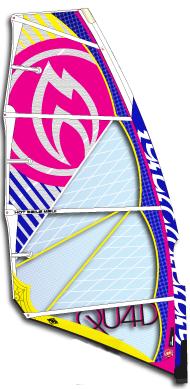
Hot Sails Maui's new QU4D is a clear example of this trend. The largest sails (5.2 and 5.6) rig on a 400cm mast. HSM's web site, though, says the 5.2 can rig on a 370, too. The 3.5 rigs on a 310 which you used to only see when rigging a yoot rig.
| Size | Luff | Boom | Ideal Mast | # of Battens | Weight (LB) |
|---|---|---|---|---|---|
| 3.5 | 0 | 0 | 310 | 4 | 0 |
| 3.9 | 366 | 143 | 340 | 4 | 5.7 |
| 4.3 | 377 | 151 | 370 | 4 | 6 |
| 4.7 | 388 | 163 | 370 | 4 | 6.4 |
| 5.2 | 407 | 172 | 400 | 4 | 6.6 |
| 5.6 | 421 | 180 | 400 | 4 | 7 |
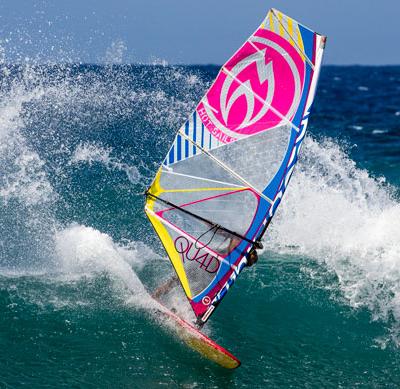
I'm a little teapot...
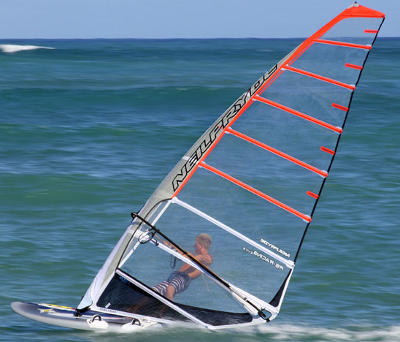
Neil Pryde's latest race sail, the RS:Racing EVOV hews more to the traditional shape, its purpose being speed. Below are the specs for the larger sizes and, for comparison, the 5.8 EVOV
| Size | Luff | Boom | # of Battens | Cams | Ideal Mast |
|---|---|---|---|---|---|
| 5.8 | 429 | 185 | 7 | 4 | 400 |
| 9.5 | 539 | 238 | 7 | 4 | 520 |
| 10.0 | 551 | 250 | 8 | 5 | 520 |
| 10.7 | 572 | 264 | 8 | 5 | 550 |
| 12.0 | 592 | 280 | 8 | 5 550 |
The original:
The challenger:
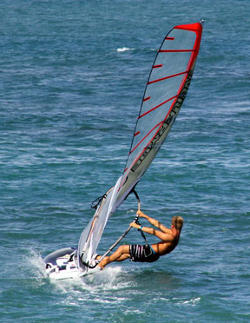
"Come on and twist. Yeah, baby, twist.
Oooh-yeah, just like this "
It's interesting to note that, while big race sails still need big sticks, the smaller ones, like their wave brethren, are trending towards shorter masts. Not that long ago, a 5.8 was definitely a sail to be rigged on a 430 or, even occasionally, a 460.
The largest EVOV sizes, 10.0 - 12.0, are optimized for Formula racing. Pryde's website indicates that the 10.0 is intended for a higher wind range than the 9.5 for both rec sailors and pros.
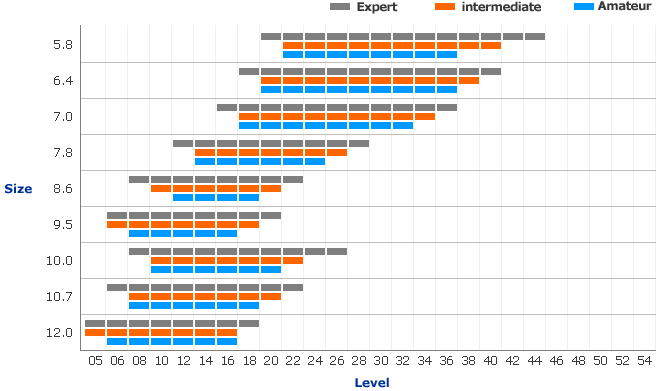
EVOV suggested wind ranges. Note how much wind the 7.0 is intended for. Race sails aren't designed for the timid.
What's the final take on this? Are shorter sails this year's fashion trend? Probably not as they are the result of attempting to optimize for certain sailing and handling characteristics. Even if you are cynical, given the high cost of carbon fiber masts(thank you, Boeing), if we get equivalent handling but spend less on sticks, that's okay by us.
For the younger among us, imagine a band that at one time or another had Jack White, Matt Bellamy and Dan Auerbach as guitarists. (For us old farts, White Stripes/solo, Muse and The Black Keys, respectively). The Yardbirds was such a band, counting Eric Clapton, Jimmy Page and Jeff Beck among its roster.
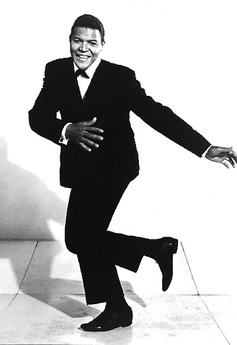
Any guess as to what the units for "Level" are on the x-axis, i.e knots, mph, fps, kph, furlongs/fortnight, etc.?
Bill Herderich
My operating assumption was knots. More universal than mph (not uncommon in places that are otherwise metric) and looking at the chart - that seems about right.
Edit: Charts for other NP sails show knots.
http://www.neilpryde.com/sails/freewave/2013-atlas.html